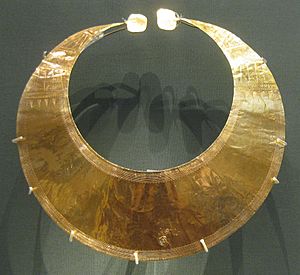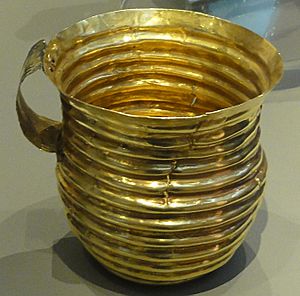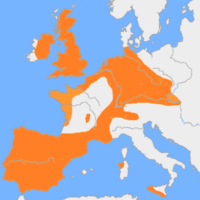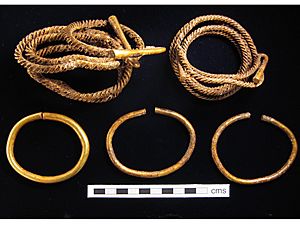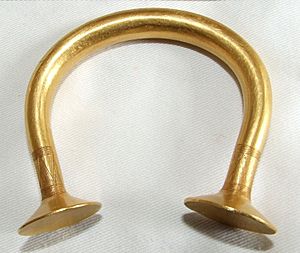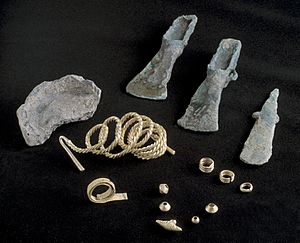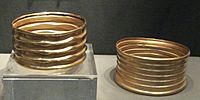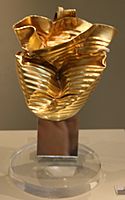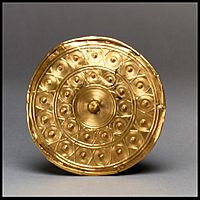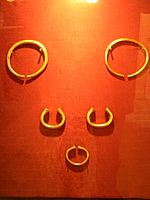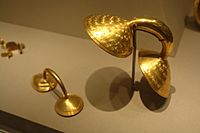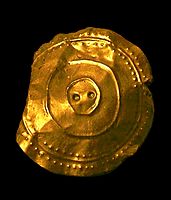Gold working in the Bronze Age British Isles facts for kids
Imagine a time long ago, around 2500 to 550 years before Jesus was born. This was the Bronze Age in the British Isles (that's Britain and Ireland). People back then learned how to work with metals like copper and bronze. But the most amazing metal they used was gold!
Gold working means making cool stuff out of gold. In the Bronze Age, gold items were super special. They showed that someone was important or had high status. People wore them as jewelry or were buried with them.
Archaeologists have found about 1,500 gold objects from this time. About 1,000 of these are from Ireland, and 500 from Britain. This might seem like a lot, but experts think many thousands more were made and used! Sadly, many were melted down or lost over time. Today, archaeologists study these gold treasures to learn about the people who made and wore them. They help us understand how society worked, what people traded, and even their beliefs.
Contents
Why Was Gold So Special?
Gold was a very important metal long ago, just like it is today! It was rare, which made it valuable. Gold is also amazing because it's easy to shape. You can hammer it into thin sheets or twist it without it breaking. Plus, gold doesn't rust or corrode, so it keeps its beautiful shine forever. People in the Bronze Age probably thought gold was not just pretty but also had a special, perhaps even magical, meaning.
Ireland had a lot of natural gold, so it was like an "ancient El Dorado" (a legendary city of gold) for gold workers!
What Was the Bronze Age?
The "Bronze Age" is a name archaeologists use for a time when people started using bronze to make tools and weapons. Before this, they mostly used stone. The Bronze Age in Britain lasted from about 2500 BCE to 800 BCE. In Ireland, it went on a bit longer, until about 550 BCE.
A group of people called the "Beaker culture" came to the British Isles from Europe. They were super skilled at working with metal. They made things from copper, like daggers, and also beautiful gold objects. They even used gold to decorate other items.
Amazing Gold Designs
Bronze Age gold items often look simple but are very elegant. They usually have cool geometric patterns like straight lines, zig-zags, or circles. These patterns are often tiny and made with incredible skill, especially on pieces from Ireland. If you look closely at the pictures of the lunula or the Irish bracelet, you can see how detailed they are!
Most of these gold objects were jewelry. People wore them as:
- Clothes fasteners (like big buttons)
- Torcs (stiff neck rings or bracelets)
- Bracelets
- Gold lunulae (crescent-shaped necklaces)
- Small ornaments for ears, noses, hair, or clothes
- Thin discs or plaques that might have been sewn onto clothing or worn in the hair.
Sometimes, the ends of these gold pieces would get thicker before flattening out. You can see this in items like the Milton Keynes Hoard. Also, tightly wound spirals were very popular, just like in other parts of Europe.
Early Bronze Age Gold
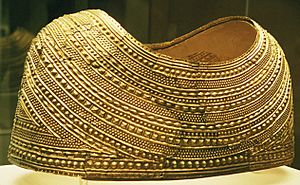
About 250 gold objects from the Early Bronze Age have been found. Most of these (165) are from Ireland, and 83 are from Britain. The earliest gold items in Britain show that a new way of making things arrived with the Beaker culture.
Early Bronze Age gold pieces were usually smaller. Thin, decorated discs or plaques were common. Two small gold cups were found in England: the Rillaton Cup and the Ringlemere Cup.
Because Ireland had so much natural gold, it had a very busy metal-working industry in the Early Bronze Age. They made lots of metal axes, daggers, and especially many gold lunulae and gold discs.
Late Bronze Age Gold
As the Bronze Age continued, society in the British Isles changed. It seems like there was even more gold available! This led to people making much bigger and heavier gold items.
The largest pieces were necklaces, like wide, flat collars called "gorgets." These had ribbed patterns and round discs on the sides. The Mold Cape is a unique gold item from this time. It's a huge gold cape that covered the shoulders and chest. It was probably worn for special events, not everyday use, because you couldn't even raise your arms while wearing it!
In Ireland, the fancy lunulae necklaces were replaced by gold torcs, and then later by those amazing "gorgets." Nine of these gorgets still exist today, and seven are in the National Museum of Ireland.
Designs with twisted bars or ribbons became popular, probably inspired by ideas from Europe. These "ribbon torcs" were simple and flexible. People loved them for a very long time, even into the later Iron Age.
Gold and Society
In the Bronze Age, gold items were a big deal. Archaeologists believe that people who owned or were buried with gold had a very high position in their society. Gold showed off their wealth and importance. It was a way to show who was in charge or who was special in the community.
How We Found These Treasures
Most Bronze Age gold items weren't found by archaeologists digging carefully. Instead, they were often discovered by accident! Farmers might find them while working in their fields, or people cutting peat (a type of fuel) might stumble upon them.
In recent times, people with metal detectorists have helped find many important gold objects. For example, the amazing Shropshire bulla was found by a metal detectorist in 2018.
People started becoming interested in these old gold items a long time ago. In 1696, the Ashmolean Museum in Oxford got its first Bronze Age gold piece. Later, in 1782, the British Museum in London got its first one too.
In the 20th and 21st centuries, archaeologists like Joan J. Taylor and George Eogan have studied these gold treasures very closely. They wrote books that helped us understand not just how the gold was made, but also what it tells us about the people and societies of the Bronze Age.
Images for kids
-
The Ringlemere Cup in the British Museum.
-
Copies of the Milton Keynes Hoard.
-
The Shropshire bulla from England, around 1000 BC.
-
The Banc Ty'nddôl sun-disc from Wales, around 2450-2150 BC.


